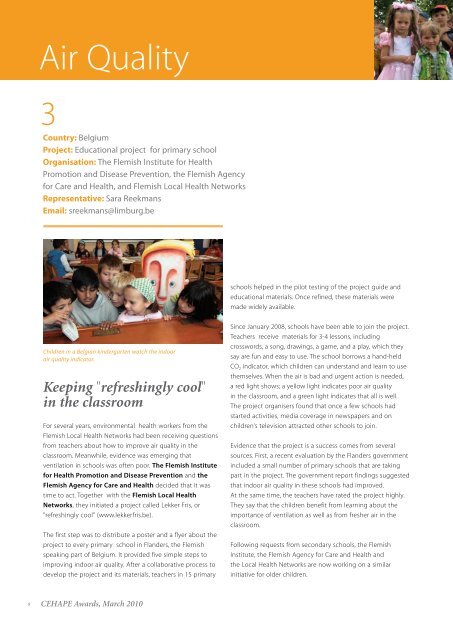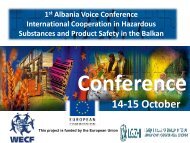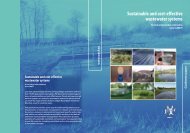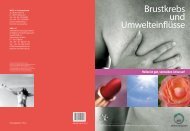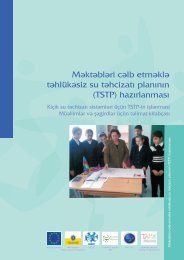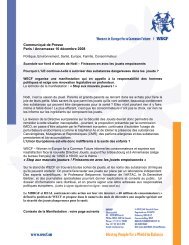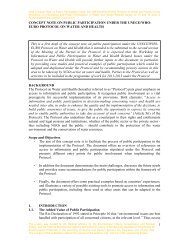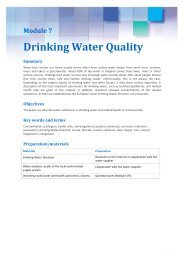Environmental measures to improve children's health - Health and ...
Environmental measures to improve children's health - Health and ...
Environmental measures to improve children's health - Health and ...
Create successful ePaper yourself
Turn your PDF publications into a flip-book with our unique Google optimized e-Paper software.
Air Quality3Country: BelgiumProject: Educational project for primary schoolOrganisation: The Flemish Institute for <strong>Health</strong>Promotion <strong>and</strong> Disease Prevention, the Flemish Agencyfor Care <strong>and</strong> <strong>Health</strong>, <strong>and</strong> Flemish Local <strong>Health</strong> NetworksRepresentative: Sara ReekmansEmail: sreekmans@limburg.beschools helped in the pilot testing of the project guide <strong>and</strong>educational materials. Once refined, these materials weremade widely available.Children in a Belgian kindergarten watch the indoorair quality indica<strong>to</strong>r.Keeping "refreshingly cool"in the classroomFor several years, environmental <strong>health</strong> workers from theFlemish Local <strong>Health</strong> Networks had been receiving questionsfrom teachers about how <strong>to</strong> <strong>improve</strong> air quality in theclassroom. Meanwhile, evidence was emerging thatventilation in schools was often poor. The Flemish Institutefor <strong>Health</strong> Promotion <strong>and</strong> Disease Prevention <strong>and</strong> theFlemish Agency for Care <strong>and</strong> <strong>Health</strong> decided that it wastime <strong>to</strong> act. Together with the Flemish Local <strong>Health</strong>Networks, they initiated a project called Lekker Fris, or"refreshingly cool" (www.lekkerfris.be).The first step was <strong>to</strong> distribute a poster <strong>and</strong> a flyer about theproject <strong>to</strong> every primary school in Fl<strong>and</strong>ers, the Flemishspeaking part of Belgium. It provided five simple steps <strong>to</strong>improving indoor air quality. After a collaborative process <strong>to</strong>develop the project <strong>and</strong> its materials, teachers in 15 primarySince January 2008, schools have been able <strong>to</strong> join the project.Teachers receive materials for 3-4 lessons, includingcrosswords, a song, drawings, a game, <strong>and</strong> a play, which theysay are fun <strong>and</strong> easy <strong>to</strong> use. The school borrows a h<strong>and</strong>-heldCO 2 indica<strong>to</strong>r, which children can underst<strong>and</strong> <strong>and</strong> learn <strong>to</strong> usethemselves. When the air is bad <strong>and</strong> urgent action is needed,a red light shows; a yellow light indicates poor air qualityin the classroom, <strong>and</strong> a green light indicates that all is well.The project organisers found that once a few schools hadstarted activities, media coverage in newspapers <strong>and</strong> onchildren‘s television attracted other schools <strong>to</strong> join.Evidence that the project is a success comes from severalsources. First, a recent evaluation by the Fl<strong>and</strong>ers governmentincluded a small number of primary schools that are takingpart in the project. The government report findings suggestedthat indoor air quality in these schools had <strong>improve</strong>d.At the same time, the teachers have rated the project highly.They say that the children benefit from learning about theimportance of ventilation as well as from fresher air in theclassroom.Following requests from secondary schools, the FlemishInstitute, the Flemish Agency for Care <strong>and</strong> <strong>Health</strong> <strong>and</strong>the Local <strong>Health</strong> Networks are now working on a similarinitiative for older children.8 CEHAPE Awards, March 2010


